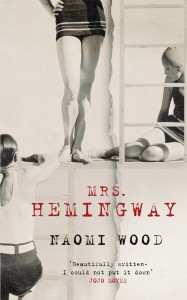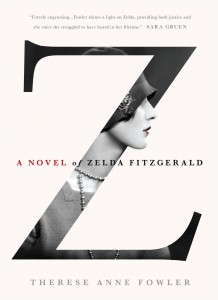The Wife’s Tale? Through the Eyes of Women Who Loved Famous Men
by Kate Braithwaite
 Readers with an eye to what is hot in historical fiction might well have observed a recent trend. Novels focusing on a famous man, told from the perspective of his wife or mistress – or wives and mistresses – are proving so popular that readers might wonder if a subgenre of fictional biography is emerging. Fact-based stories of difficult men, geniuses even, revealed through the eyes of the women who loved and lived with them: the book club appeal is obvious. But is it as simple as that?
Readers with an eye to what is hot in historical fiction might well have observed a recent trend. Novels focusing on a famous man, told from the perspective of his wife or mistress – or wives and mistresses – are proving so popular that readers might wonder if a subgenre of fictional biography is emerging. Fact-based stories of difficult men, geniuses even, revealed through the eyes of the women who loved and lived with them: the book club appeal is obvious. But is it as simple as that?
In 2007, Nancy Horan’s Loving Frank (Ballantine) brought Frank Lloyd Wright to life on the page through the story of Mamah Cheney, a clever, charming woman who falls in love with the architect she and her husband have chosen to build their new home. Because it is Mamah’s story, it can only take the reader into one time period in Wright’s life, but happily, the reader can turn to The Women (Viking, 2009) for more. T.C. Boyle begins with Wright’s last wife, Olga, and works backwards. Much of the novel is devoted to his second wife, Miriam Wright, then Mamah, and to a much lesser extent Katherine, his first wife of twenty-six years.
But is The Women really his wives’ tale at all? The story is told by a fictional apprentice of Wright’s, and the third-person narrative gives voice to Frank’s thoughts and emotions as well as to his women’s. Interestingly, while Loving Frank superficially fits the criterion of a story of a great man told through the perspective of his wife or mistress, it becomes much more. Loving Frank is Mamah’s story, whereas The Women, where the point of view is more fluid, is thoroughly and unashamedly a book about one dominating, difficult and magnetic man.
It is intriguing, then, to pick up The Paris Wife (Ballantine, 2011) and consider how Paula McLain tells the story of the first Mrs Hemingway, Hadley. Although several years his elder, Hadley is always the innocent one, the constant, loving wife to Ernest as he struggles to establish himself as a writer and within the literary circles of Paris in the 1920s. Hadley tells the story of her marriage from their first meeting in Chicago to the salon of Gertrude Stein, from the bullfights of Pamplona to the beaches of Antibes. The portrait of Hemingway that emerges is complex, fascinating and, above all, believable. Hadley says of him:
“He was such an enigma, really – fine and strong and weak and cruel. An incomparable friend and a son of a bitch. In the end there wasn’t one thing about him that was truer than the rest. It was all true.”
Hadley Hemingway is no Mamah Cheney. As a character she remains largely unchanged through the novel. He doesn’t tell the story, but The Paris Wife truly is all about Hemingway. It is Hemingway who grows and changes, finding a new world, new friends and ultimately a new woman, the glamorous Pauline, perhaps a more suitable partner to a literary legend in the making.
Readers who enjoyed The Paris Wife can look forward in 2014 to the publication of Mrs Hemingway (Penguin) by Naomi Wood.
With intricate structuring, Wood weaves together the stories of the four Mrs Hemingways into a novel that is poignantly sympathetic to each woman in turn, as each falls for and then loses Ernest Hemingway. Each woman’s story starts with the end of their relationship, overlapping and contrasting with the story of the woman to come. But in other chapters, Wood takes the women back to the time when they first became involved with Hemingway, so that the reader re-visits the woman before, but from the next woman’s point of view. The novel that emerges is beautifully written, highly evocative of time and place, and emotionally charged. And most strikingly, each wife is given her own distinct voice. As his third wife, Martha, on the verge of being replaced, wryly observes, Hemingway, “without a woman, would be a writer in want of a wife.”
But it is not only famous artists who have wives or mistresses with stories to tell.
The Aviator’s Wife(Delacorte, 2013) by Melanie Benjamin is the fictional biography of Anne Morrow Lindbergh, the wife of Charles Lindbergh. This is a story of a marriage in an unprecedented glare of publicity and of the challenges of marrying an extraordinary man. But it is not a novel about Charles Lindbergh. This is firmly Anne’s story: the story of a woman married to a difficult man, a woman whose first child is kidnapped, a woman obliged to countenance her famous husband’s misplaced support for Hitler and Nazi Germany and a woman who finds her own voice and writes Gift from the Sea, her much loved thoughts on life, love and marriage. In a story told in the first person by Anne Lindbergh, the reader looking to understand Charles Lindbergh will be left disappointed, as ultimately, it seems Anne herself was, but Anne’s story is fascinating in its own right.
Also in 2013 came Above All Things (Amy Einhorn/Putnam) by Tanis Rideout, more of a two-handed affair than a straightforward “wife’s tale.” Here, a third-person narrative of George Mallory’s attempt to conquer Mount Everest in 1924 intertwines with his wife Ruth’s first-person story as she waits at home for news from the Himalayas. Canadian author Rideout visited the Pepys Library at Magdalene College, Cambridge, where she studied letters between George Mallory and his wife. Certainly the perspective of Mallory’s wife is central to the success of the novel. The intensely driven George is humanized by his wife, and the story’s tense climax relies upon the juxtaposition of his obsessive desire to climb Everest and her patient, agonized wait at home with their young children.
Ruth Mallory might have had to battle a mountain in order to keep her husband by her side, but other wives have had more human competition. In two novels set in the nineteenth century, readers meet the mistresses of two famous men: Edgar Allan Poe and Sigmund Freud.
Lynn Cullen’s Mrs Poe (Gallery, 2013) constructs a dark love story from evidence (although disputed) of a romantic relationship between Edgar Allan Poe and the poet Frances Osgood. In 1845, Edgar Allan Poe is the lauded author of “The Raven,” but he lives in poverty with his ailing young wife, Virginia, and his mother-in-law, Mrs Clemm. He meets Frances Osgood, a mother and poet who is living with friends after having been abandoned by her philandering painter husband. Through Frances Osgood’s eyes, Cullen brings us Eddie – passionate, headstrong and ambitious, but also tormented – a credible character to have produced Tales of Mystery & Imagination.
In Freud’s Mistress (Amy Einhorn/Putnam, 2013) by Karen Mack and Jennifer Kaufman, Minna Bernays is an independent-thinking, unmarried young woman in a world – Vienna at the end of the nineteenth century – that was not kind to women of her stamp. Reluctantly, she moves into the home of her sister and brother-in-law, Sigmund Freud, who is not yet the renowned father of psychoanalysis. Freud, though, is someone who treats Minna as a person with a mind, and the story follows her seemingly inevitable attraction to him and the consequences that play out as a result. Minna’s choices and internal conflict provide the main drama of the novel. That her lover is a famous man adds interest for the reader, and insights into Freud’s character are there to be enjoyed, but ultimately both Freud’s Mistress and Mrs Poe, perhaps because less is known about the two men, have a much more fictional feel than the stories based in the twentieth century.
“Wives’ tales,” then, are a more diverse group than they might appear. In some the famous man resonates as the main character, while in others the unsung wife or mistress is the person whose story predominates. This tussle most vividly comes to life in the case of F. Scott and Zelda Fitzgerald.
In Z: A Novel of Zelda Fitzgerald (St Martin’s, 2013) by Therese Anne Fowler, Zelda leaps from the pages as the glamorous, inspiring flapper wife who struggles to find a space for her own creativity and live in happiness with her novelist husband. The novel opens with Scott’s pursuit of Zelda: the society belle of Montgomery Alabama, and a girl with an eye for financial security. His desire to win her becomes the driver for Fitzgerald’s ambition to be a writer, and they marry in New York just as his first novel, This Side of Paradise, is published. Initially the story reads as a fascinating window into the world of the Lost Generation, a hedonistic mix of alcohol, the Jazz Age and the beginning of celebrity. But progressively, Zelda’s struggle to find her self and creative identity become the central story of the book. She writes, but her stories are published either under Scott’s name alone or jointly. Neglected and alone while Scott struggles to write The Great Gatsby, she falls in love with another man. And when she turns to dance to express herself and find her own success, it becomes apparent that there is only room for one genius in this partnership. As with The Aviator’s Wife, in Z, a novel that might be about the husband turns out to be, quite rightly, the story of the wife.
Fowler, in her afterword, writes about the challenge for historical novelists writing about real people:
“Fiction based on real people differs from nonfiction in that the emphasis is not on factual minutiae but rather on the emotional journey of the characters. I’ve striven to create the most plausible story possible, based upon all the evidence at hand.”
This neatly sums up what these novels have in common. Regardless of whose tale is told and how, each writer takes the facts and makes them fly off the page. For those who want the “real” people, there are plenty of avenues to explore. Whether with Hemingway’s A Moveable Feast, Zelda Fitzgerald’s Save Me the Waltz and/or F. Scott’s Tender is the Night, or Anne Lindbergh’s Gift from the Sea – starting with a deceptively simple “wife’s tale” can lead to so much more.
About the contributor: KATE BRAITHWAITE is currently writing Charlatan, a novel about another famous mistress, Athénaïs, Madame de Montespan. Recipient of the 2011 Marina Nemat Writing Award from Toronto University, she has published short fiction and a range of book reviews and interviews for the HNS.
______________________________________________
Published in Historical Novels Review | Issue 67, February 2014






